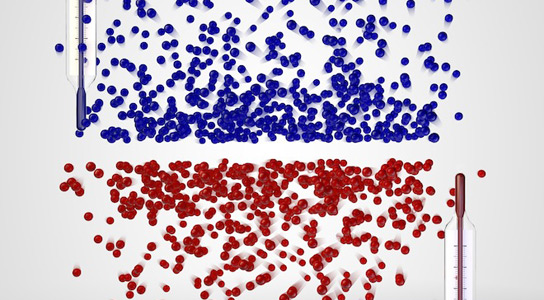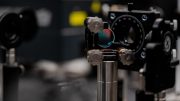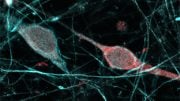
Energy distribution of atoms in a thermal state. Positive absolute temperatures above, in blue; negative absolute temperatures below, in red. Credit: LMU/MPQ Munich
Physicists have been able to create an atomic gas that can attain a temperature below absolute zero, -273.15˚C (-459.67˚F). They were able to create this gas using negative-Kelvin materials and new quantum devices.
The scientists published their findings in the journal Science¹. The absolute temperature scale dates back to Lord Kelvin, who created it in the mid-1800s. It was designed in a way that nothing could be colder than absolute zero. Later, physicists discovered that the absolute temperature of a gas is related to the average energy of its particles. Absolute zero corresponds to a theoretical state in which particles have no energy, and higher temperatures correspond to higher-than-average energies.
In the 1950s, physicists working with exotic systems started to realize that this wasn’t always true. Temperatures of a system are read off from a graph that plots the probabilities of its particles being found with certain energies. Most particles have average or near-average energies, with only a few having higher energies. In theory, if more particles have higher energies, the plot would flip around and the sign of the temperature would change from positive to negative.
Ulrich Schneider, a physicist at the Ludwig Maximilian University in Munich, Germany, and his colleagues reached a sub-absolute zero temperature with an ultracold quantum gas that was made up of potassium atoms. They used lasers and magnetic fields to keep the atoms in a lattice arrangement. At positive temperatures, the atoms repel, making the whole configuration stable. When the magnetic fields were adjusted, causing the atoms to attract rather than repel each other, the atoms shift from their most stable state to the highest possible energy state.
At positive temperatures, such a reversal is unstable as the atoms would collapse inwards. The trapping laser field was also adjusted to make it more energetically favorable, allowing the atoms to stick in their current positions. The gas then shifted from a temperature above absolute zero to a few billionths of a Kelvin below absolute zero.
Exotic high-energy states are hard to generate in the laboratory. These techniques allow these states to be studied in detail, possibly allowing the creation of new forms of matter in the laboratory. Such systems would behave in strange ways. Clouds of atoms that are usually pulled downwards by gravity would be pulled upwards, apparently defying gravity.
A sub-absolute-zero gas mimics dark energy, the force that pushes the Universe to expand at an ever-faster rate, against the pull of gravity.
Reference; “Negative Absolute Temperature for Motional Degrees of Freedom” by S. Braun, J. P. Ronzheimer, M. Schreiber, S. S. Hodgman, T. Rom, I. Bloch and U. Schneider, 4 January 2013, Science.
DOI: 10.1126/science.1227831









Gas laws are only for real matter particle where absolute zero is the least temperature one can attain, since less than that would mean zero and negative energy. Here in the experiment the quantum gases are in a fourth state like ionic core of sun or central core of earth, where they they descend from the gaseous state. Here pure ions work without coupling with each other. In the experiment also going below absolute temperature of -273.15 degrees celcius means not the property of ordinary matter. Already superconductivity and strange properties near absolute zero are known for physicists. Thank You.
Negative Absolute Temperature
A.
http://www.quantum-munich.de/
Negative Absolute Temperature
“We could for the first time observe a negative absolute temperature for mobile particles. By using an intermediate bosonic Mott insulator together with a Feshbach resonance in bosonic Potassium we were able to create a stable attractive Bose gas at negative absolute”.
B.
Energy-Mass Poles Of The Universe
http://universe-life.com/2012/11/14/701/
C.
Negative absolute temperature cannot be attained in a Singularity state in which there is zero distance between the elementary particles such as the pre-Big-Bang gravitons singularity. It can be attained with other particles which arrive at non-zero inter distance in their state of minimum motion, minimum energy level, by lowering temperature. In such a system a consequent application of “compacting energy” will effect a “coerced pseudo-Big-Bang”…
D.
From: http://www.nature.com/news/quantum-gas-goes-below-absolute-zero-1.12146
“Another peculiarity of the sub-absolute-zero gas is that it mimics ‘dark energy’, the mysterious force that pushes the Universe to expand at an ever-faster rate against the inward pull of gravity. Schneider notes that the attractive atoms in the gas produced by the team also want to collapse inwards, but do not because the negative absolute temperature stabilises them. “It’s interesting that this weird feature pops up in the Universe and also in the lab,” he says. “This may be something that cosmologists should look at more closely.”
Again and again: Dark energy YOK!. See “Energy-Mass Poles Of The Universe” above and ponder “absolute singularity” versus “pseudo singularity”…
Dov Henis (comments from 22nd century)